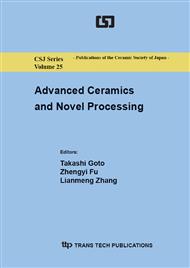[1]
S.Iijima, Helical microtubules of graphitic carbon, Nature 354 (1991) 56–58.
DOI: 10.1038/354056a0
Google Scholar
[2]
G.E. Thompson, R.C. Furneaux, Nucleation and growth of porous anodic films on aluminium, Nature 272 (1978) 433–435.
DOI: 10.1038/272433a0
Google Scholar
[3]
Y. Piao, H. Lim, J.Y. Chang, Nanostructured materials prepared by use of ordered porous alumina membranes, Electrochimica Acta 50 (2005) 2997–3013.
DOI: 10.1016/j.electacta.2004.12.043
Google Scholar
[4]
H. Chiriac, T. A. Ovari, A. E. Moga, M. Urse, Preparation and magnetic properties of Ni80Fe20 nanowire arrays, J. Optoelectron. Adv. M. 5 (2003) 257–260.
Google Scholar
[5]
C.R. Martin, Sol−Gel Template Synthesis of Semiconductor Nanostructures, Chem. Mater. 8 (1997) 1739–1746.
Google Scholar
[6]
Y. Okawa, M. Aono, Nanoscale wiring by controlled chain polymerization, Surf. Sci. 514 (2002) 41–47.
DOI: 10.1016/s0039-6028(02)01605-9
Google Scholar
[7]
A. Laura, D. Bauer, H. Reich, G.J. Meyer, Selective functionalization of two-component magnetic nanowires, Langmuir 19 (2003) 7043–7048.
DOI: 10.1021/la034613b
Google Scholar
[8]
D. Crouse, Y.-H. Lo, A.E. Miller, M. Crouse, Self-ordered pore structure of anodized aluminum on silicon and pattern transfer, Appl. Phys. Lett. 76 (2000) 49–51.
DOI: 10.1063/1.125652
Google Scholar
[9]
H. Masuda, K. Fukuda, Ordered metal nanohole arrays made by a two-step replication of honeycomb structures of anodic alumina, Science 268 (1995) 1466–1468.
DOI: 10.1126/science.268.5216.1466
Google Scholar
[10]
W. Lee, R. Ji, U. Gösele, K. Nielsch, Fast fabrication of long-range ordered porous alumina membranes by hard anodization, Nature Mater. 5 (2006) 741–747.
DOI: 10.1038/nmat1717
Google Scholar
[11]
K. Konishi, T. Kubo, A. Nakahira, Characterization and some properties of TiO2 on Ti surface by anodization in acid solution, p.390–394, Water, Steam and Aqueous Solutions for Electric Power, Advances in Sci. and Tech., Maruzen, 2005.
Google Scholar
[12]
A. Nakahira, K. Konishi, K. Yokota, T. Honma, H. Aritani, K. Tanaka, Synthesis and characterization of TiO2 doped with P ions by anodic oxidation of titanium in acid solution, J. Ceram. Soc. Japan 114 (2006) 46–50.
DOI: 10.2109/jcersj.114.46
Google Scholar
[13]
A. Nakahira, K. Yokota, T. Kubo, Preparation of Ti with nanoholed TiO2 layer by anodic oxidation for medical applications, Advances in Technology of Materials and Materials Processing Journal (ATM) 9 (2007) 41–44.
Google Scholar
[14]
A. Nakahira, K. Yokota, T. Kubo, M. Takahashi, Synthesis and Characterization of TiO2 doped with S ions by anodic oxidation of titanium in acid solution, Chem. Lett. 11 (2007) 1318–1319.
DOI: 10.1246/cl.2007.1318
Google Scholar


